di Marta Lock
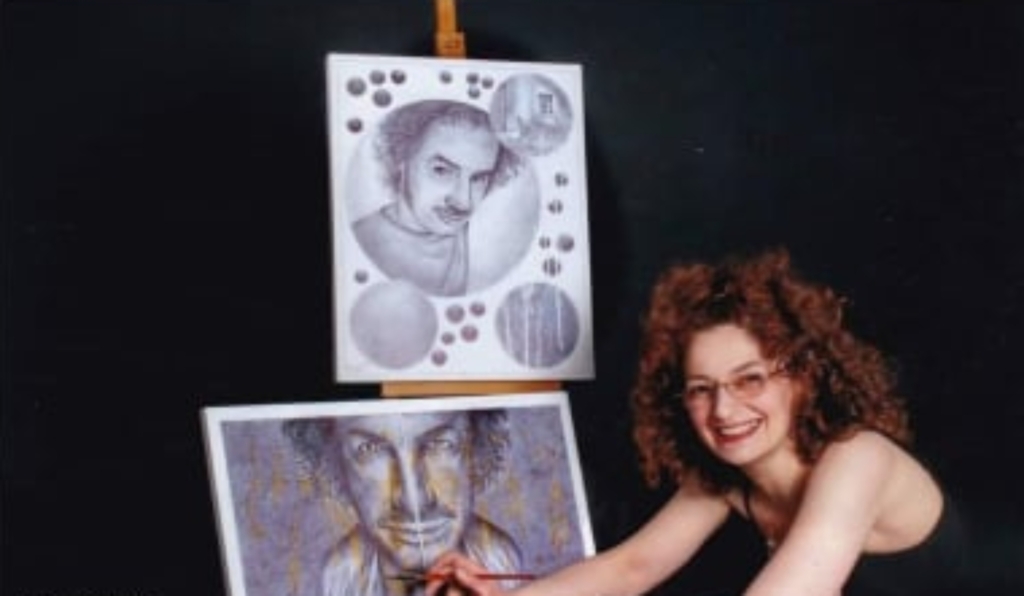
Personalità ben definita, dinamica e originale, Giusy Brescianini mostra un eclettismo creativo che la spinge a sperimentare costantemente la sua tecnica per armonizzarla ai messaggi che di volta in volta sono celati nelle sue opere nelle quali passa da un figurativo semplice e diretto quando ritrae personaggi noti o individui importanti nel suo percorso di vita, a un approccio invece molto più surrealista quando invece desidera porre l’accento sui temi salienti della società contemporanea. La sua eccentricità espressiva si sviluppa attraverso una tecnica mista in cui mescola inchiostro, china e olio spesso lasciato colorare con la tecnica del Dripping sull’opera già strutturata come se divenisse un velo che evidenzia e definisce il senso del resto della tela; ciò che affascina l’artista è il volto umano, gli sguardi e le espressioni che spesso nascondono la reale essenza mentre molte altre lasciano trapelare ciò che non vorrebbe essere rivelato. E in quelle striature di colore gocciolante si svela esattamente la tendenza di Giusy Brescianini a tralasciare il dettaglio, a non porre attenzione verso un intorno che servirebbe solo a distogliere l’attenzione da ciò che conta, dal messaggio del centro della tela necessario a catalizzare lo sguardo dell’osservatore verso il concetto oltre l’immagine. In alcune opere però il Dripping diventa funzionale a sottolineare ed enfatizzare una vicinanza e al tempo stesso una spiccata personalità ben distinta dei protagonisti ritratti, come in Father and son (Padre e figlio),
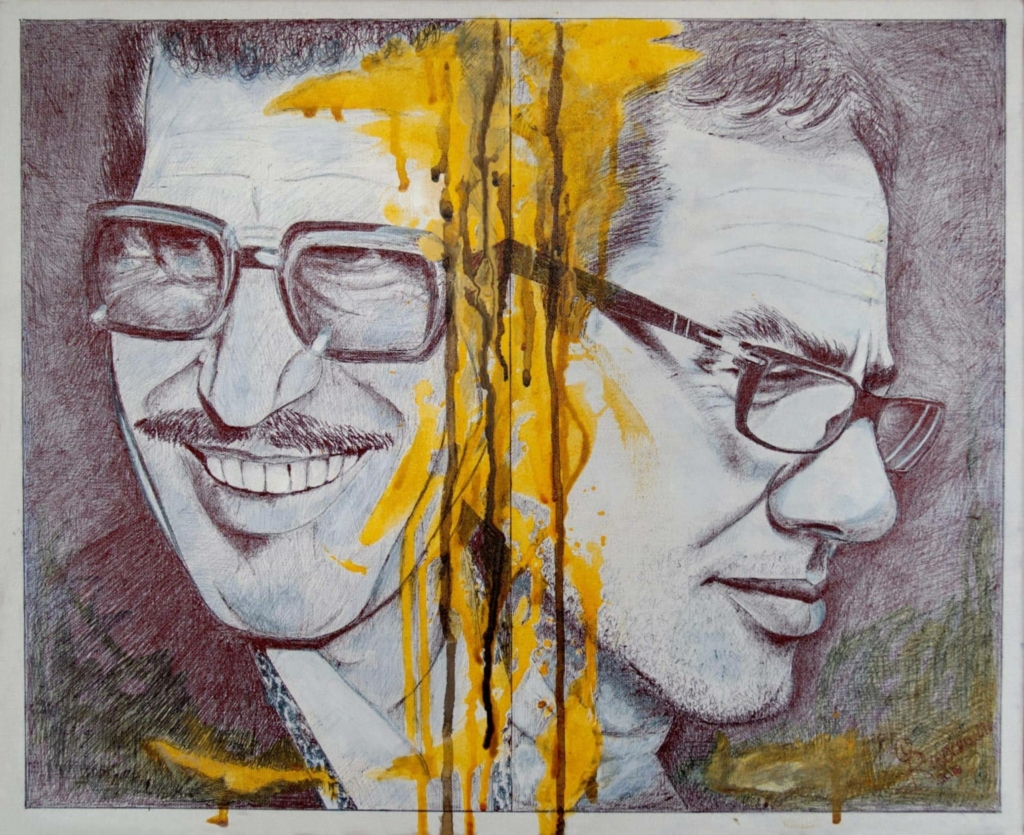
dedicata a Ciccio e Giampiero Ingrassia, dove l’artista mette in risalto il forte legame tra i due ma anche l’individualità che ha permesso al figlio di crearsi un proprio percorso professionale senza sentirsi messo in ombra dalla celebrità del padre. La linea gialla di separazione tra i due volti sembra essere esattamente quella demarcazione tra i due temperamenti necessaria a essere un confine di rispetto, di sostegno, di profondo affetto ma al tempo stesso di libertà e di ricerca di un proprio spazio, un raggio d’azione ben distinto da quello dell’altro. Quando però si sposta verso il Surrealismo l’artista pone in evidenza le fragilità umane, quelle insicurezze profonde che conducono l’individuo ad assumere atteggiamenti che pur nascendo per un’esigenza di autotutela si trasformano a lungo andare in cronicizzazioni caratteriali le quali non solo possono creare danno alle persone circostanti ma anche al protagonista stesso della posizione di autodifesa. È questo il concetto che emerge dalla tela L’ipocrisia,
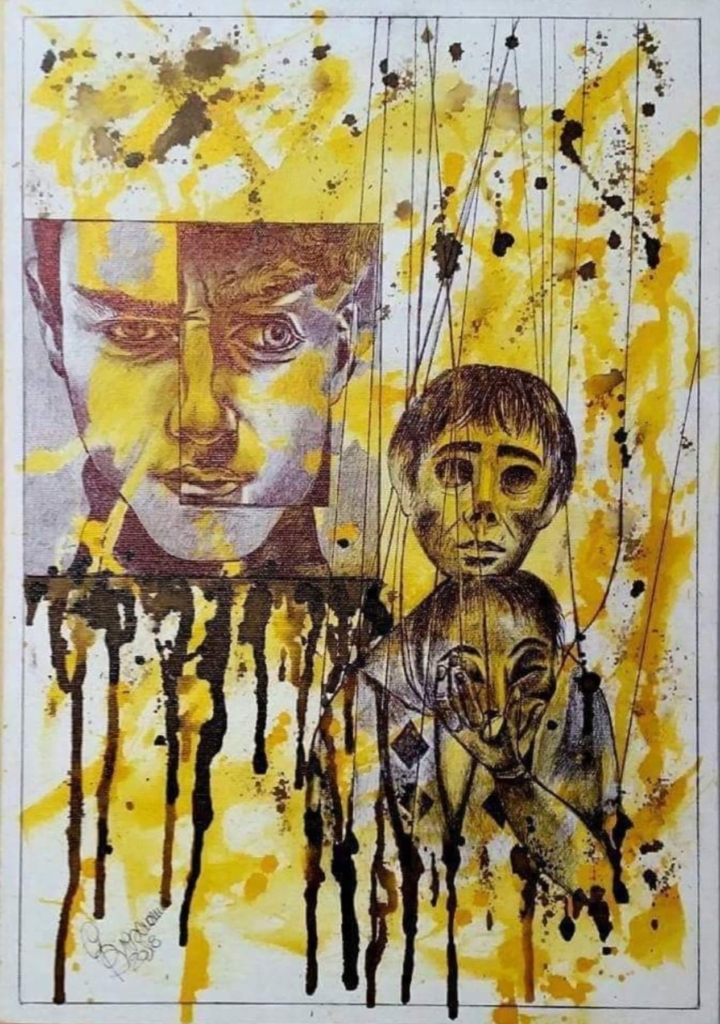
dove il volto al centro dell’opera appare diviso tra l’apparire che mostra all’esterno e quella sua vera essenza che non può fare a meno di fuoriuscire, quel suo essere acrimonioso e malevolo contro qualcosa o qualcuno che normalmente ha il solo difetto di avere di più, di essere di più, di suscitare quell’invidia spesso causa di malessere nei rapporti tra le persone. Eppure, sembra suggerire l’artista, basterebbe davvero molto poco per lasciare indietro le sensazioni negative e restare sintonizzati su un’apertura verso l’altro che renderebbe le interrelazioni più semplici, meno ostili, inducendo gli individui ad abbassare una maschera che a quel punto non avrebbe più ragione di esistere. Il giallo dello sfondo assume la doppia valenza di assecondarsi alla gelosia ma al tempo stesso di trasformarsi in un invito alla solarità, alla positività, alla gioia di lasciarsi andare a un modo di vivere più semplice, più spontaneo e più orientato a non vedere l’altro come un antagonista, qualcuno su cui vincere, bensì semplicemente come un diverso da noi con cui interagire e da cui poter apprendere qualcosa di nuovo. Profonda osservatrice della psiche e delle emozioni umane, Giusy Brescianini mostra un approccio bivalente alla vita, da un lato la capacità empatica di comprendere anche ciò che non viene detto o che vorrebbe restare nascosto, dall’altro la positività e la forza di carattere che la induce ad affrontare anche le difficoltà con l’atteggiamento positivo e aperto attraverso cui riesce a esorcizzare i propri timori e a vincere gli ostacoli esterni. Andiamo ora a scoprire di più su questa dinamica artista.
Giusy, vorremmo scoprire come è cominciato il suo percorso artistico. Si è formata da autodidatta oppure ha seguito studi specifici? C’è stato un momento in cui ha capito che l’arte sarebbe stata la sua strada, o invece ha intrapreso subito questo percorso perfezionandosi e lasciando che il suo stile personale fuoriuscisse con il tempo?
L’avventura con l’arte è iniziata nel 1974 con il premio Andersen. Sono stata segnalata e premiata dalla critica per l’accostamento cromatico e la capacità interpretativa per l’opera Cenerentola al ballo che era contraddistinta da un’esplosione di colori. Da quel momento in avanti ho sentito la necessità di frequentare corsi di pittura e poi la scuola d’arte; posso dire che tutto sia stato frutto di un percorso spontaneo, inevitabile perché completamente affine alla mia inclinazione naturale. L’arte è entrata nella mia vita fin da subito dunque, avvolgendomi e riempiendo le mie vene di furibonde dolcezze.
La sua tendenza all’approfondimento dei rapporti interpersonali e dei comportamenti quasi automatici della società contemporanea vengono da un attento ascolto di tutto ciò che le ruota intorno. Quanto è importante l’approfondimento e la capacità di autoanalisi in un vivere moderno che galleggia in superficie? E quanto l’arte può costituire un mezzo per imparare a riflettere?
Definirei l’approfondimento frutto di una sensibilità magica poiché consente di comprendere i cambiamenti dello spazio e del tempo, quei sottili movimenti che si possono intravedere solo se particolarmente predisposti a un ascolto empatico di tutto ciò che ruota intorno. Le strade dell’arte sono infinite, bisogna pensare, mescolare, diluire, annusare e infine creare. Ogni mia visione mi aspetta in una specie di bolla dorata dove mi soffermo e seguo il ritmo dei miei pensieri. L’arte è un tormento terapeutico e l’andare oltre, lo scavare al di là della superficie è fondamentale per effettuare quel percorso di consapevolezza che poi può essere esternato attraverso l’opera e, di conseguenza, trasportare l’osservatore verso la medesima sfera interiore che intendo mettere in evidenza e stimolarlo alla riflessione.
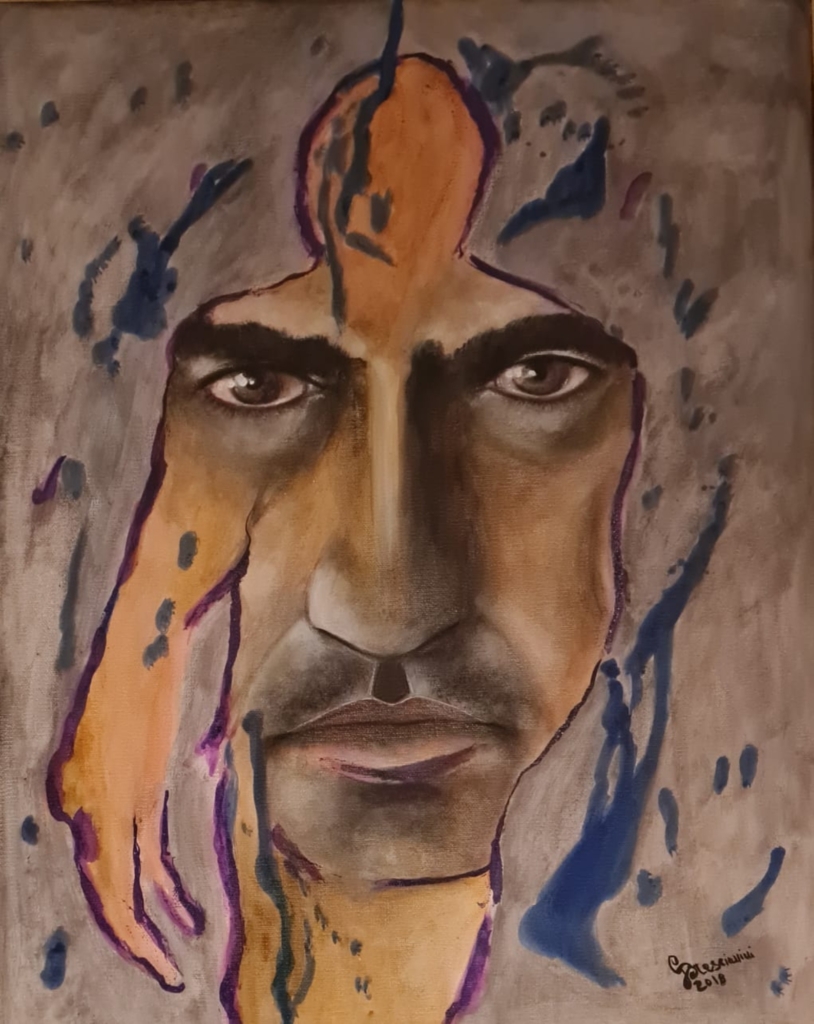
Il suo stile è a metà tra Surrealismo ed Espressionismo con l’aggiunta di tecniche che appartengono all’Arte Informale, come il Dripping; come è nato questo particolare linguaggio espressivo? E verso quale evoluzione sta tendendo in questa fase pittorica? Il mio particolare linguaggio espressivo nasce dall’idea di creare un forte contrasto tra lo sfondo e le figure perché il mio intento è quello di dar vita a un tratto pittorico che enfatizzi la vitalità dell’opera in un contesto ricco di simboli, quindi deve esaltare l’immagine complessiva senza distogliere l’attenzione dai significati che desidero mettere in luce. Questa fase pittorica sta evolvendo in una incessante e multiforme ricerca che non so dove mi condurrà, so solo che il bisogno primario è quello di lasciarmi andare alle trasformazioni che di opera in opera si generano
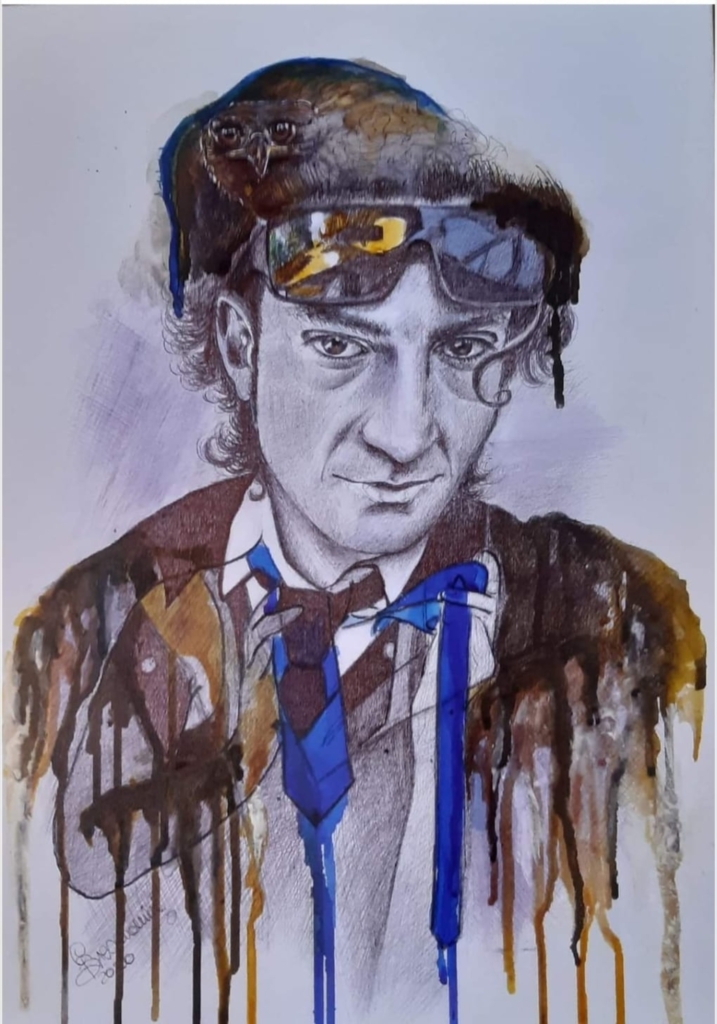
Spirit in the sky (Spirito nel cielo)
Quanto è complesso oggi farsi strada nel mondo dell’arte? Quali sono secondo lei le insidie e le difficoltà che gli artisti incontrano più frequentemente? Il mondo dell’arte contemporanea è complicato e a volte difficile; l’artista deve distinguersi per originalità e ricerca in un costante bombardamento di immagini e soprattutto su una molteplicità di autori che, giustamente, desiderano emergere. Disciplina, pazienza e determinazione sono le parole magiche che possono fare la differenza e offrire l’occasione per riuscire a rendere il proprio lavoro ampiamente riconosciuto. Una delle maggiori difficoltà che ho percepito è che a volte la gente è totalmente distante dall’opera, in sintesi, non si lascia trasportare dall’universo visionario ed evocativo proposto dall’artista.
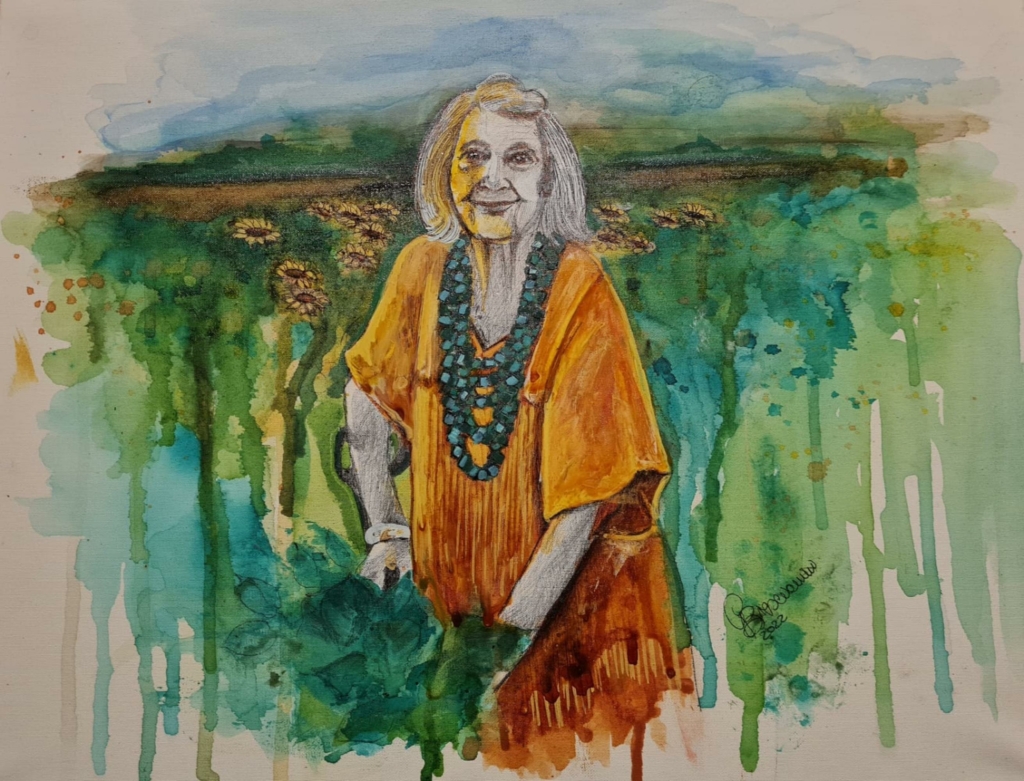
Lei partecipa regolarmente a premi e concorsi d’arte in tutta Italia e recentemente è stata selezionata da Vittorio Sgarbi per esporre nel Teatro Politeama di Palermi nell’ambito dell’evento Panorama d’Italia. Ci racconta quali sono i suoi prossimi progetti?
Devo dire che è stato molto bello ricevere l’apprezzamento di importanti addetti al settore, compresa l’attenzione di Sgarbi e dunque intendo proseguire il mio percorso partecipando a mostre collettive, ho in progetto di organizzare alcune personali in via di definizione e di continuare anche a realizzare lavori su commissione.
GIUSY BRESCIANINI-CONTATTI
Email: giusybres@alice.it
Facebook: https://www.facebook.com/giusy.brescianini.3
Linkedin: https://www.linkedin.com/in/giusy-brescianini-9605a78b/
Instagram: https://www.instagram.com/giusybresc/
Marta Lock’s interviews:
Giusy Brescianini, the expressive eccentricity of a constantly evolving pictorial research
Well-defined, dynamic and original personality, Giusy Brescianini displays a creative eclecticism that pushes her to constantly experiment her technique in order to harmonise it with the messages that are concealed in her artworks, in which she switches from a simple and direct figurative style when portraying well-known personalities or important individuals in her life, to a much more surrealist approach when she wishes to emphasise salient themes of contemporary society. Her expressive eccentricity is developed through a mixed technique in which she mixes ink, Indian ink and oil, often left to colour with the Dripping technique on the already structured artwork as if to become a veil that highlights and defines the meaning of the rest of the canvas. What fascinates the artist is the human face, the looks and expressions that often conceal the real essence while many others let through what they would not like to be revealed. And in those dripping streaks of colour is revealed exactly Giusy Brescianini’s tendency to leave out the detail, to pay no attention to the surroundings that would only serve to distract attention from what matters, from the message in the centre of the canvas necessary to catalyse the observer’s gaze towards the concept beyond the image. In some paintings, however, dripping becomes functional to emphasise and underline a closeness and at the same time a distinct personality of the portrayed protagonists, as in Father and son, dedicated to Ciccio and Giampiero Ingrassia, where the artist highlights the strong bond between the two but also the individuality that has allowed the son to create his own career path without feeling overshadowed by his father’s celebrity. The yellow dividing line between the two faces seems to be exactly that demarcation between the two temperaments needed to be a boundary of respect, support, deep affection, but at the same time of freedom and the search for one’s own space, a range of action distinct from that of the other. When, however, she moves towards Surrealism, the artist points out human fragilities, those deep-seated insecurities that lead the individual to assume attitudes that, although born out of a need for self-protection, in the long run turn into character chronicisations that can not only cause harm to those around them but also to the protagonist of the self-defence position itself. This is the concept that emerges from the canvas Hypocrisy, where the face at the centre of the artwork appears torn between the appearance it shows to the outside world and its atrue essence that cannot help but spill out, that acrimonious and malevolent being against something or someone who normally has the sole defect of having more, of being more, of arousing that envy often the cause of malaise in relationships between people. And yet, the artist seems to suggest, it would take very little to leave negative feelings behind and remain tuned in to an openness towards the other that would make interrelations simpler, less hostile, inducing individuals to lower a mask that would then no longer have any reason to exist. The yellow of the background takes on the double valence of indulging in jealousy but at the same time turning into an invitation to cheerfulness, positivity, the joy of letting oneself go to a simpler, more spontaneous way of life, more oriented towards not seeing the other as an antagonist, someone to win over, but simply as someone different from us with whom to interact and from whom we can learn something new. A profound observer of the human psyche and emotions, Giusy Brescianini displays a bivalent approach to life, on the one hand the empathic ability to understand even what is unsaid or would like to remain hidden, and on the other the positivity and strength of character that leads her to face even difficulties with the positive and open attitude through which she manages to exorcise her own fears and overcome external obstacles. Let us now find out more about this dynamic artist.
Giusy, we would like to find out how your artistic career began. Did you train as an autodidact or did you follow specific studies? Was there a moment when you realised that art would be your path, or did you immediately embark on this route, perfecting yourself and letting your personal style emerge with time?
My adventure with art started in 1974 with the Andersen Prize. I was noted and rewarded by the critics for my colour combination and interpretative skills for the artwork Cinderella at the Ball, which was characterised by an explosion of colours. From that moment on, I felt the need to attend painting courses and then art school; I can say that everything was the result of a spontaneous path, inevitable because it was completely akin to my natural inclination. Art entered my life right from the start, therefore, enveloping me and filling my veins with furious sweetness.
Your tendency to deepen interpersonal relationships and the almost automatic behaviour of contemporary society come from a careful listening to everything that revolves around you. How important is depth and the capacity for self-analysis in modern living that floats on the surface? And how much can art be a means of learning to reflect?
I would define deepening as the fruit of a magical sensibility because it allows one to understand changes in space and time, those subtle movements that can only be glimpsed if one is particularly predisposed to empathetic listening to everything that revolves around. The paths of art are endless, one must think, mix, dilute, smell and finally create. Each of my visions awaits me in a kind of golden bubble where I linger and follow the rhythm of my thoughts. Art is a therapeutic torment and going beyond, digging beyond the surface is essential to carry out that path of awareness that can then be externalised through the artwork and, consequently, transport the observer to the same inner sphere that I intend to highlight and stimulate him to reflection.
Your style is somewhere between Surrealism and Expressionism with the addition of techniques that belong to Informal Art, such as Dripping; how did this particular expressive language come about? And towards what evolution are you tending in this pictorial phase?
My particular expressive language stems from the idea of creating a strong contrast between the background and the figures because my intention is to create a pictorial stroke that emphasises the vitality of the artwork in a context rich in symbols, so it must enhance the overall image without distracting attention from the meanings I wish to highlight. This pictorial phase is evolving into an incessant and multiform research that I do not know where it will lead me, I only know that the primary need is to let myself go to the transformations that are generated from work to work.
How complex is it to make your way in the art world today? What do you think are the pitfalls and difficulties that artists encounter most frequently?
The world of contemporary art is complicated and sometimes difficult; the artist must distinguish himself through originality and research in a constant bombardment of images and above all a multiplicity of authors who rightly wish to emerge. Discipline, patience and determination are the magic words that can make the difference and offer the opportunity to succeed in making one’s work widely recognised. One of the greatest difficulties I have perceived is that sometimes people are totally distant from the artwork, in short, they do not get carried away by the visionary and evocative universe proposed by the artist.
You regularly participate in art prizes and competitions all over Italy and were recently selected by Vittorio Sgarbi to exhibit at the Politeama Theatre in Palermo as part of the Panorama d’Italia event. Can you tell us what are your next projects?
I must say that it was very nice to receive the appreciation of important people in the sector, including Sgarbi’s attention, so I intend to continue my path by participating in group exhibitions, I am planning to organise some personal exhibitions that are currently being defined, and I also intend to continue to produce artworks on commission.
